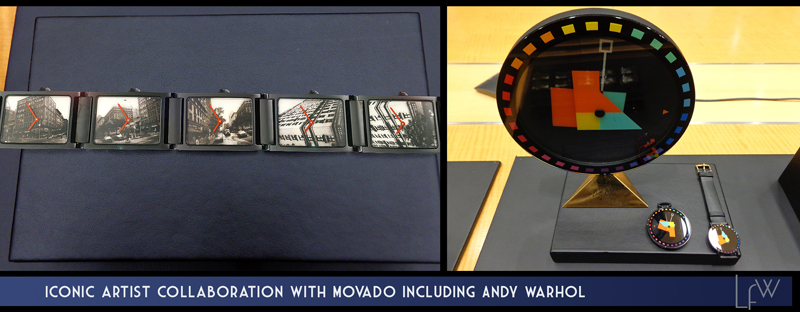A look inside the rich archives of this influential watchmaker.
I personally have always loved vintage Movado watches, and after speaking to other vintage watch collectors, my appreciation for this brand is shared by many in community.

Prior to my appointment with Stephanie Riccoboni, the person in charge of the Movado archive department, I had to brush up on my knowledge about the company’s history, founder, innovations, and watches. For this, I turned to the seminal book on the topic, The Movado History by Fritz Von Osterhausen.
In 1881, Achille Ditesheim founded his company, LAI Ditesheim & Freres SA in La Chaux-de-Fonds, Switzerland. Starting with just a team of six people, the company grew at a rapid pace and by 1897, there were eighty employees working there. In fact, LAI Ditesheim & Freres SA was the second largest employer in the industry at that time with Jaeger-LeCoultre in the lead with about 100 people and Audemars Piguet in a distant third with a staff of ten people.
The company’s main business was producing pocket watches, which were assembled individually using parts supplied by other companies. They then finished the movements in-house.
At the end of the 19th century, the company began producing in-house watches using their own components. Shortly thereafter, in 1905, the name Movado was introduced, which is a word meaning “always in motion” in Esperanto—a language created by Ludwik Zamenhof in 1887.

Using History
It turns out that Movado is the perfect name since the company has continuously been in action to stay ahead of its time. Movado continues to use its past to create its future.
The Ditesheim family members at the helm of Movado were true visionaries in horology, filing an impressive ninety-eight patents to their name from 1900 to 1969. There was the 1912 Movado Polyplan designed with a revolutionary patented “form” movement to accommodate the curve of the watch.
Then there was the 1914 Movado “Soldier’s Watch” with a protective grill that was popular during WWI, the 1926 Movado Ermeto square pocket watch, the 1938 Movado monopusher chronograph, the Calendograf, the Celestograf, the Calendomatic, the Datron, the world time and the Artists’ Series, which included the Andy Warhol timepiece.

However, out of all of Movado’s innovations, the two that stand out to me the most are Movado’s first automatic chronograph with Zenith’s El Primero movement (called the Datron HS 36 caliber at Movado) and of course, the now-iconic Museum watch created by Nathan Horwitt in 1947.
Unfortunately, the 1970s was a dark decade for Movado. The Grinberg family purchased the company in 1983 and turned it into the Movado Group with the aim of bringing back the spirit and passion of the Ditesheim days.
The Movado Archives
The official Movado library and archives are located in New Jersey. Stephanie Riccoboni—who has worked at Movado for 12 years—is the librarian in charge. With such an in-depth knowledge of Movado’s history, she works very closely with Movado’s master watchmaker, the marketing team, and the business development team.
After the Grinberg family purchased Movado more than thirty-five years ago, the company began the process of developing an archive of historic vintage Movado watches. Movado continues collecting pieces today and is constantly scouting auction houses, private collections and even Instagram for timepieces.
It was fascinating to browse through a place with shelves after shelves of reference books, drawers filled with caliber drawings and sketches, piles of original sales catalogs, billboards, displays, and other brand paraphernalia.
Today, the Movado Group has more than 1,200 vintage watches (including pieces from Movado, Ebel, and Concord)—each one carefully photographed and filed in photo albums.

These pieces are pre-mass production timepieces, assembled by hand. They are an important resource for current designers of the company to understand the history and heritage of Movado.
According to Riccoboni, the archive and library are for internal use and serve as a source of inspiration for current collections. It is telling that the design department is only a couple of steps away from the library and archives. The company also stores all the current supplier samples, from movements to materials and everything in between. So it is a constant back and forth between vintage inspiration and modern innovation—always in motion, so to speak.
The library conducts other projects like digitalizing handwritten references and documents. The archive department also monitors auctions to identifying what vintage Movado watches are being sold and at what prices.
While the department does not officially authenticate Movado watches (like Patek Philippe does with its “extracts from the archive” service) the Movado team is always ready to help when people reach out to the company for information.

Thanks to the archive and reference library, Movado launched the 1881 Automatic in 1990 to mark the 100th-year anniversary, which included designs similar to the original Movado Curviplan, Calendomatic, and other vintage models. Furthermore, Movado is able to offer the Heritage Series collection, which pays tribute to the designs of vintage watches like the Calestograf, Calendoplan or the Datron, but produces them to suit modern expectations.
The archive department is key to modern-day Movado. New members of the design and product development teams are expected to spend time doing their homework by studying the archive and library extensively to discover and appreciate the spirit of the company and the fundamentals of the watches. Stephanie Riccoboni and the library/archive department are really the gatekeepers to both Movado past and present. It is where Movado treasures are kept. There is a real sense of pride among the people who work at Movado.
Riccoboni says it best when she commented that the archive is, “A reminder of the people who came before us and committed themselves to a product that we are responsible to carry forward.”
I left the Movado headquarters with an even greater appreciation for the company. I am happy to report that the current custodians of the brand are genuinely carrying on the spirit of the Ditesheim family.
Laurent Martinez is the proprietor of Laurent Fine Watches
Greenwich, Connecticut. Read more by him at blog.laurentfinewatches.com
or visit his store’s site at www.laurentfinewatches.com










